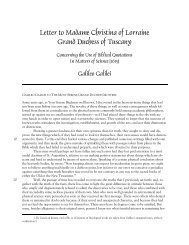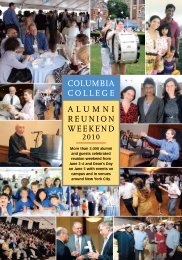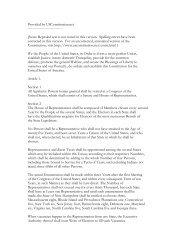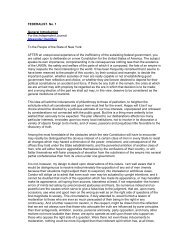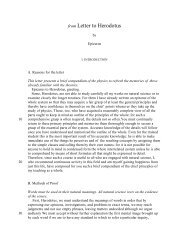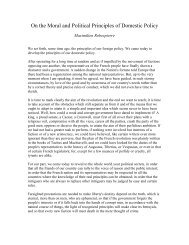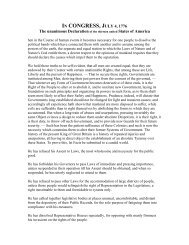Download this issue as a PDF - Columbia College - Columbia ...
Download this issue as a PDF - Columbia College - Columbia ...
Download this issue as a PDF - Columbia College - Columbia ...
You also want an ePaper? Increase the reach of your titles
YUMPU automatically turns print PDFs into web optimized ePapers that Google loves.
KENNETH T. JACKSON<br />
COLUMBIA COLLEGE TODAY<br />
COLUMBIA COLLEGE TODAY<br />
KENNETH T. JACKSON<br />
William W. Havens ’46 GSAS, who began his career working on<br />
the Manhattan Project at <strong>Columbia</strong> and w<strong>as</strong> for nearly two decades<br />
the University’s director of nuclear science and engineering,<br />
scans the screen of a cloud chamber in Pupin, watching the<br />
tracks of nuclear particles. The chamber is an apparatus, weighing<br />
more than 300 lbs., for making visible the paths of submicroscopic<br />
nuclear particles.<br />
PHOTO: MANNY WARMAN, COLUMBIA UNIVERSITY, COURTESY COLUMBIA<br />
UNIVERSITY ARCHIVES<br />
sand were war-related; <strong>this</strong> w<strong>as</strong><br />
at a time when one million men<br />
from the area were in the armed<br />
services. The year before, almost<br />
three-hundred new industrial<br />
plants opened in New York between<br />
January and April. The<br />
products turned out in the city’s<br />
factories were wide-ranging: air -<br />
plane parts, metal products, spun<br />
gl<strong>as</strong>s fibers, optical lenses and<br />
prisms, dehydrated foods, bombs,<br />
canv<strong>as</strong> goods, tents, tarpaulins,<br />
haversacks, leggings, mattress<br />
covers, powder bags, bandages,<br />
and life preservers. The Canal<br />
Street area w<strong>as</strong> covered with<br />
small electrical and metal shops,<br />
many of which contracted with<br />
the War Department.<br />
The Brooklyn Navy Yard w<strong>as</strong><br />
the busiest such facility in the<br />
world. With more than seventyfive<br />
thousand employees (versus<br />
over fifty-five thousand at the<br />
Philadelphia Navy Yard or more<br />
than twenty thousand at the<br />
Wilmington Shipyard) working<br />
seven days a week and around<br />
the clock between 1942 and 1945,<br />
the “yard” w<strong>as</strong> a world unto itself.<br />
Its two-hundred-ninety acres contained seven huge dry docks,<br />
forty-seven mobile cranes on tracks, eight piers, two colossal steel<br />
shipways, two twelve-hundred foot-long graving docks, foundries,<br />
machine shops, warehouses, a power plant, and a hospital.<br />
It w<strong>as</strong> crisscrossed by nineteen miles of paved streets and thirty<br />
miles of rails. Pier G w<strong>as</strong> home to the Hammerhead, the largest<br />
crane in the world at the time. And just outside the gates were<br />
more than eighty supporting factories, which together reduced the<br />
amount of materials that needed to be transported there.<br />
The Navy Yard w<strong>as</strong> the foremost builder of battleships in the<br />
world, and it produced more of them than Japan during World<br />
War II. The U.S.S. Arizona, which w<strong>as</strong> bombed and sunk at Pearl<br />
Harbor — taking more than one-thousand sailors to an early<br />
death — w<strong>as</strong> built there at the end of World War I. So too w<strong>as</strong> the<br />
battleship U.S.S. Missouri, on whose deck the Japanese formally<br />
surrendered on September 2, 1945. In addition, the workers at the<br />
Brooklyn Navy Yard built battleships Iowa and North Carolina and<br />
five aircraft carriers (including the Franklin D. Roosevelt, the Bon<br />
Homme Richard, the Bennington, the Kearsarge, and the Oriskany).<br />
They also constructed eight large ships designed to ferry tanks<br />
onto the beaches on D-Day.<br />
Warships built at other facilities were frequently brought to the<br />
Brooklyn Navy Yard to be fitted with guns. More than five thousand<br />
other ships were repaired<br />
at the yard during World War II,<br />
including the Royal Navy battleship<br />
H.M.S. Malaya, which w<strong>as</strong><br />
refitted in Brooklyn to relieve the<br />
pressure on British shipyards.<br />
The Brooklyn Navy Yard w<strong>as</strong><br />
but one of forty ship-building<br />
and ship-repair facilities in the<br />
city. Bethlehem Steel’s Staten<br />
Island yard built forty-seven<br />
destroyers, seventy-five landing<br />
craft, five cargo ships, and three<br />
ocean-going tugs during the war.<br />
Todd Shipyards in Brooklyn’s<br />
Erie B<strong>as</strong>in had 19,617 employees<br />
in 1943, occupied mainly with<br />
building and repairing destroyers.<br />
They reputedly could take a<br />
vessel that had been badly damaged<br />
by a German torpedo and<br />
put it back in service in a matter<br />
of days. Over the course of the<br />
war, Todd repaired and refitted<br />
some three hundred vessels and<br />
built twenty-four landing craft<br />
of the type which took American<br />
soldiers to the beaches of<br />
Normandy on D-Day.<br />
Other New York factories<br />
were equally busy with work.<br />
New York’s most important contribution to the<br />
war effort — the Manhattan Project — remained a<br />
secret until long after the final surrender.<br />
Inside a converted ice plant on Marcy Avenue in Brooklyn, Pfizer<br />
— a Brooklyn company founded by two German immigrants in<br />
1849 — built the first factory to m<strong>as</strong>s-produce the world’s first<br />
life-saving antibiotic, penicillin. Having beaten other companies<br />
in finding a way to m<strong>as</strong>s-produce the brand-new drug, Pfizer<br />
bought the ice plant on September 20, 1943, and quickly converted<br />
the factory into the first penicillin factory in the world. Amazingly,<br />
within three months of the plant’s opening on March 1,<br />
1944, it produced most of the penicillin to go <strong>as</strong>hore with American<br />
troops on D-Day, June 6, 1944. By that date, American penicillin<br />
production w<strong>as</strong> one-hundred billion units per month, and<br />
Pfizer w<strong>as</strong> making more than fifty percent of it. An advertisement<br />
of the time depicted four military men and women at the center<br />
of a line of civilians. Beneath them, a caption read, “These are<br />
alive today…because of PENICILLIN.”<br />
The Carl L. Norden Company developed and manufactured<br />
the top-secret Norden bombsight for the Army Air Forces, which<br />
needed it for bombardiers over Germany and Japan. The Norden<br />
Company had its headquarters and major production facility<br />
at 80 Lafayette Street in Manhattan and an additional factory<br />
at 50 Varick Street. Meanwhile, the Sperry Gyroscope Company<br />
in Brooklyn and the Ford Instrument Company in Long Island<br />
City were producing other devices to help naval gunnery officers<br />
adjust their aim to control for the<br />
tossing of the sea.<br />
In Queens, the Steinway<br />
Piano Company manufactured<br />
glider wings on behalf of General<br />
Aircraft Corporation. On D-Day,<br />
these gliders were towed behind<br />
regular aircraft and then cut loose<br />
over drop zones in France to take<br />
airborne <strong>as</strong>sault troops behind<br />
enemy lines. Aircraft parts were<br />
made in Long Island City, and<br />
the Aluminum Corporation of<br />
America built a 101-acre, 1.1-million<br />
square-foot plant along M<strong>as</strong>peth<br />
Creek that employed ten<br />
thousand workers and produced<br />
millions of tons of aluminum.<br />
The City’s garment industry,<br />
long the center of American<br />
clothing manufacture, produced<br />
a substantial number of military<br />
uniforms. The Amalgamated<br />
Clothing Workers of America negotiated<br />
for the Army and Navy<br />
contracts to be dispersed among<br />
its many union shops in different<br />
cities, but New York w<strong>as</strong> <strong>as</strong>sured<br />
that its fifty thousand metropolitan-area<br />
members would have<br />
work. A contract for more than<br />
1.2 million overcoats (valued at<br />
$2.8 million) w<strong>as</strong> <strong>issue</strong>d in 1942.<br />
New York and Philadelphia<br />
shared a contract for one hundred<br />
thousand Navy uniforms,<br />
and the Army gave contracts for<br />
one-hundred-twenty five thousand<br />
garments to shops in Brooklyn<br />
and Manhattan. The United<br />
States Naval Clothing Depot, at<br />
Third Avenue and 29th Street in<br />
Brooklyn, w<strong>as</strong> among the largest<br />
and most sophisticated clothing<br />
production and distribution<br />
plants in the world. Within its walls, over a thousand employees<br />
manufactured, packaged, and shipped all the white twill and blue<br />
flannel uniforms and auxiliary garments that were worn by sailors<br />
of the entire United States Navy.<br />
In the New York area, heavy industry w<strong>as</strong> located in the suburbs<br />
rather than in the city itself. Long Island in particular had been<br />
important in aviation history from the time the Wright Brothers<br />
first demonstrated the possibility of controlled flight. Republic Aviation’s<br />
Farmingdale plant made more than fifteen thousand P047<br />
Thunderbolt fighters, many of which provided air support above<br />
Allied armies in Europe. Similarly, Grumman Aircraft Engineering<br />
Corporation in Bethpage w<strong>as</strong> the major production center for the<br />
Navy’s Hellcat fighter planes and Avenger torpedo bombers. And<br />
in New Jersey, the Curtiss-Wright Company made aircraft engines<br />
and propellers in Caldwell and Paterson.<br />
Many of the metropolitan area’s contributions to Allied victory<br />
were intellectual and psychological rather than physical. The city’s<br />
(Top) John R. Dunning ’34 GSAS (left) and Eugene T. Booth at the<br />
control panel of a cyclotron in the b<strong>as</strong>ement of Pupin in 1967.<br />
At that site, 25 years earlier, they witnessed the first demonstration<br />
of atomic fission in the United States. (Above) A certificate<br />
awarded by the War Department to <strong>Columbia</strong> in 1945 for its part<br />
in the Manhattan Project.<br />
PHOTOS: COURTESY COLUMBIA UNIVERSITY ARCHIVES<br />
media prowess w<strong>as</strong> tapped in<br />
the service of the war effort. From<br />
the former Paramount Studios<br />
lot in Astoria, Queens, the Army<br />
Pictorial Service made military<br />
training films and instructed<br />
combat cameramen and photographers.<br />
At its peak it had both<br />
military and civilian employees,<br />
including famous New York<br />
and Hollywood filmmakers, the<br />
most renowned of whom w<strong>as</strong><br />
John Huston, director of The Maltese<br />
Falcon. Particularly moving<br />
w<strong>as</strong> the story of Harold Russell,<br />
a demolition expert who lost his<br />
hands. To inspire other maimed<br />
soldiers, he w<strong>as</strong> the focus of a<br />
film made in Queens called Diary<br />
of a Sergeant. Russell later became<br />
better known when he starred in<br />
the 1946 Hollywood film The Best<br />
Years of Our Lives.<br />
But New York’s most important<br />
contribution to the war effort<br />
remained a secret until long after<br />
the final surrender. The development<br />
of the atomic bomb began<br />
in the Pupin Physics Laboratories<br />
of <strong>Columbia</strong> University, where<br />
Leo Szilard and Nobel laureate<br />
Enrico Fermi, among others, began<br />
experimenting with nuclear<br />
fission. The early effort employed<br />
a group of physicists at <strong>Columbia</strong>,<br />
while members of the football<br />
team helped move hundredpound<br />
packs of uranium. After<br />
1942, the bomb’s production w<strong>as</strong><br />
overseen by the Army Corps of<br />
Engineers. The Corps named the<br />
project the Manhattan Engineer<br />
District, believing that following<br />
the convention of naming engineering<br />
commands for the city in<br />
which they were headquartered would avert suspicion. Eventually,<br />
even <strong>as</strong> it moved across the country, the entire undertaking<br />
would come to be known <strong>as</strong> simply the Manhattan Project. Its lead<br />
researchers moved to the University of Chicago and then to Oak<br />
Ridge, Tennessee, and Hanford, W<strong>as</strong>hington. In Los Alamos, New<br />
Mexico, the final development of the weapon occurred, headed by<br />
J. Robert Oppenheimer, who had grown up at 155 Riverside Drive<br />
on the Upper West Side.<br />
© The New-York Historical Society, 2012. Reprinted from WWII & NYC<br />
with the permission of New-York Historical Society and Scala Publishers<br />
Ltd. WWII & NYC w<strong>as</strong> published in conjunction with the exhibition<br />
WWII & NYC, which w<strong>as</strong> on view <strong>this</strong> year at the New-York Historical<br />
Society, recalling New York’s crucial and multifaceted role in winning the<br />
war while commemorating the 900,000 New Yorkers who served in the<br />
military and exploring the many ways in which those who remained on<br />
the home front contributed to the national war effort.<br />
SUMMER 2013<br />
40<br />
SUMMER 2013<br />
41




